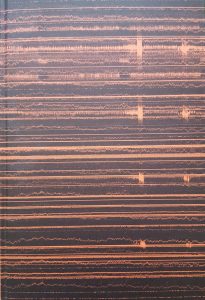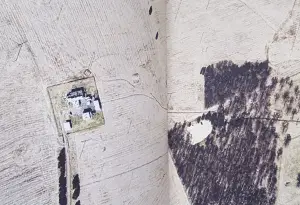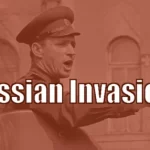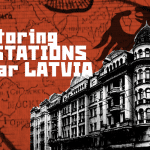
Since the so-called numbers stations monitoring became a hobby for some, a very few books have been written about the subject. For it’s not actually easy to write a printed book about radio broadcasts. The question is how we perceive these stations. For some, they are interesting radio broadcasts they keep track of, create endless logs, make schedules for them and focus on their technical side; the transmission type, quality, the ID and group count. The research of numbers stations remains purely descriptive. But, then we ask what is all for and what it means and what does it represent? This is a harder question to answer and that’s why most just would like to focus on technical side because surely it’s convenient. Because it’s the secrecy that covers these stations. Without the means of one-time pads and codebooks, no one could decode these broadcasts themselves. Without no deep investigation and observation of person receiving and decoding the number station, no one can tell to whom its meant with precision. This is the work of counterintelligence who had uncovered such cases but in most cases, the documents uncovering the numbers station use are still under secrecy. The notable document collection is FBI Operation Solo that documented the use of numbers stations by Soviets within the US. And in this case, we only know about such station and such operation 40 years later. But, there are numbers stations on the air now and in fact, I just heard on a minute ago! Who uses them? Again a difficult question. No one in the intelligence agency in the right mind would never admit, the counterintelligence also will not disclose it to the public – that is not how it works. So when you see numbers stations log like E07 Russia, S11a Poland or S06s Ukraine this is based on perceptions. This is determined by mostly by triangulation data, the reception data of where the station has the strongest signal and to where the signal is broadcasted. This is the technical side, again. Then comes the determination of the broadcast structure. It’s apparent that intelligence agencies use their own cryptography systems. Nowadays there is a family of stations like from S06 to V07 that has common broadcast structure. As it’s perceived, these stations come from Russia. Then there is a counter family of stations like E11 and S11a that are supposed to come from Poland. However, when we hear S06s and E17z we label them as Ukrainian. And they use the same structure as Russian stations. Why do we think that? Because of triangulation data that traces the origins of these broadcasts in West Ukraine. And maybe you noticed we again diverted into details and missed the big picture. Why it’s important? Why waste time on this? Why talk about this? This where the new book by Lewis Bush comes in. The Shadows of the State is not just about numbers stations and their broadcast sites it’s about the state within a state, a Leviathan that hides in the deep waters, but when it strikes from the depths it can destroy the whole nations. In case of the intelligence agency, it is a state within the state that is supposed to serve the state it’s the part of. However, had the intelligence agency become too powerful and enters the political level and starts affecting state and society directly, the Leviathan can no longer be defeated, nor kept hidden in the sea.
Lewis Bush is photographer and educator, who gives lectures on photojournalism at the London College of Communication and gives guest lectures at other high education facilities. With historian education from the Warwick University, he has his own unique view on history and politics. His previous works are the Memory of History (2012) about the perception of historical events in ten European countries affected by economic recession and social issues. The War Primer 3 (2013) tells about the critique of the relationship between war and photography and Metropole (2015) is written about how London is redeveloped by aggressive developers and speculators. From the view of the radio specialists in its technical side, the authors seemingly non-connection to communication subject this can be seen as weakness. Then from another side, this is an advantage as being a neutral observer not involved with radio monitors, their trials and errors, the author can produce an objective outlook on the complicated subject.
Shadow of State as his previous books can be viewed differently. It can be seen as a high-res picture book with short but detailed text. It can be used as a good reference book on all the most known numbers stations and their supposed locations. Then it can be viewed as one person’s rather eccentric artistic approach to cast light of what he calls the shadow of the state and rise his concern of the dangers for the democratic society this state has.
He writes: Democracy is defined by due process and accountability; intelligence gathering is like a negative image of this. In fact, democracy or “rule of the people” is rather an idealistic illusion than actual state system. Sometimes its abuse becomes so apparent as it becomes ridiculous as the Democratic Peoples Republic of Korea. Democracy is also not a mob rule. Democracy is more a rule by a group of people which gathers in parties or party coalitions, takes and holds power according to laws they had written that also include the election and security laws. The weaker these laws are, more prone is the state to constant change in leadership as voters minds shift from left to right and centre. Intelligence and security agencies, as well as the army, should protect both the ruling faction and the voters who elected them. Realistically speaking a democratic political system based on the regular change of leadership and governmental policies only weaken the intelligence and military service. When these services for at least four and five years tries to adjust to one ruling party and its elected ministers then after the new election they have to put up with newly elected leadership that sees things otherwise. Intelligence agency and army become very powerful when its allied with monarchy or stable dictatorship government. They both need each other. King or dictator needs secret police to defend him and his regime and realize their policy goals. Secret police receive state attention, funding and privileged status. This works well unless the monarch or dictator is weak and neglects his own guard dog and then guard dog may turn on him. As in case of the democratic system: one president can favour its guard dog and feed him well. The other one hates it did not trust it and wants to get rid off. Then the agency has its concerns and considerations: should we go along and obey the elected leader and the law, or should we use or leverage to affect politics and even remove the politicians we don’t like. This is an example of past Richard Nixon administration who was very hostile to CIA, causing it to start gathering compromising sources that led to Nixon’s resignation. This same process is apparent now when Donald Trump is at odds with both CIA and FBI while both are trying to gain the upper hand over each other. This is a dangerous game when intelligence agency and the military is at odds with politicians and may want to command them instead because they know better than voters who elected them. Then the state of intelligence and military becomes one with the civic state and Leviathan has swallowed them.
The author argues that the purpose of his book is not to give all answers to all questions about the numbers stations. Instead, this book should shed light on these activities and demonstrate how these activities take place within our society and most of it ignores it and is not even aware of. He argues while intelligence and security are vital for the defence of democracy and society “democracy ultimately often ends up becoming the victim of its own defence”. [..] To refuse to look, and to allow these activities to go largely unscrutinised is to drift further into a dark inversion of the democratic ideal: a nightmare realm where state secrecy becomes the end rather than the means, where democracy contorts into authoritarianism, and where the shadow state at democracy’s back breaks free.” This is not an out of proportion warning. This what happened to Russia since 2000 where the director of Federal Security Service Vladimir Putin became president of the state. As in case of Soviet KGB, it was the loyal guard dog of the Communist Party and its leadership. During Stalin’s reign, the secret service and army were bullied and purged on regular basis, however, during the reign of Nikita Khrushchev and Leonid Brezhnev it was no longer purged and became solid allies with the communist party leadership. However, according to KGB’s view, Mikhail Gorbachev betrayed the KGB, left it powerless and unable to prevent the fall of the union. KGB successors survived the chaos of Boris Yeltsin and made a defying revenge. Vladimir Putin’s rule is defined by the rule of so-called siloviks the members of intelligence and army who, as Andrei Soldatov has called the New Nobility, a ruling caste within the Russian society whose rights and privileges are above the rights of all Russian laws and simple citizens. The state political affairs, both internal and external are therefore accustomed to the needs and demands of the security and military. Such state in Russia has existed for almost 20 years resulting in the restart of the Cold War between Russia and the West and new kind of Russian quest for a world domination (or rather world disruption). Its often argued that against such power, the democratic and liberal powers are too weak. That we need to make our security laws stronger, our army greater and restore the draft and so on. Will the Russian Leviathan fear the other Western Leviathan? The beast does not fear another, but respects it. And that would lead to George Orwell’s world of three global totalitarian powers who are at war with each other but do not seek to destroy each other as both rely on each existence for the fear is what keeps the society under constant direct control.

(The E05 Transmitter Site at Warrenton Training Center Station C)
We now understand that this book while it’s seemingly just about these numbers stations and their transmission sites has actually deep political and historical context. We readers are immersed in the well-written introduction and the purpose. But now we must question the technique, structure and the basis of the further content. The author makes a selection of most well-known numbers stations and their history and gives the location of the radio transmitter side its supposed to transmit. This is the both the strongest and weakest point of this work. We are of course immersed in the high res satellite pictures and we are amazed that sites are known. Well, that is the issue. The radio transmission site used by intelligence agency unless it’s closed down and the agency it used has become past, like STASI in East Germany, will not be disclosed. Declassified documents and confirmations by agents and station workers who are authorized to can be trusted and then we can surely place that site on the map and in the book. In most cases however its perceptional work. Radio signal triangulation can lead us to the supposed area where the signal comes from. We have the open source maps and other means to find if there is a radio communications site there. Bu, that is not enough. The next is what we know about the site? Is there a transmission antenna capable of transmitting signals to shortwave? Even if there is, how can we be sure? One practical way is to get near the station and try to pick up the perceived radio station at full strength. As in case of Warrenton Training centre, the radio enthusiasts really managed to trace the numbers stations to the site. But, then there were events like with famous Russian military station the Buzzer. Triangulation results lead to the area around Pskov. No broadcast site was ever known there, the only noteworthy place that was located there was a FSB signal listening base. Instead, it required a methodical study of Russian military communication hubs and in the end, two possibe sites were picked up. One that is not mentioned in the book, in the Leningrad region, was confirmed by the same method with buzzer signal nearby reaching seemingly full strength. Later, however, it was reported that it no longer transmits there. However, often this station turns off the second transmitter. So if there are still two transmitters then maybe the second one in Leningrad is still used or there is another one? And the one in Moscow that is mentioned in the book has not been confirmed. This course was required to argue that we cannot fully trust the assumptions of all the locations mentioned in this book and these locations and their high-quality satellite and google street views are suggestions of these stations could use.
What we can mostly trust is the description of these stations. While some of those facts about these numbers stations are perceptions and suggestions, and aren’t concrete facts, these profiles are based on sources from numbers stations monitoring groups and books. And that is the strongest point that these descriptions exist in the book and provide to the reader not just high res satellite image, but the actual perceived history of the station and a supposed transmission site. What these descriptions lack is footnotes that would lead to the direct source of facts stated. For instance, I would like to know what is the source that says that numbers station G05 was one used by CIA Soviet Spy Alexander Ogorodnik. But as the book balances between being a picture book and a factbook, such space and paper consuming details were apparently omitted. However, the author is still a historian and all the sources: books and sites are listed in the end. Our site too – thank you for that! Thus the author helps people to find books and sites that might help to understand the numbers station and intelligence issue much better.
In conclusion the strong point of this seemingly photo book is its strong political message. The correct description of the chosen numbers station and also a reference to all known numbers stations ID. Not a weak, but simply a questionable part of the book is the numbers station transmission locations guide. Not all of them have been fully confirmed and people will argue over their locations. The methods of finding these sites are not fully exact, so expect these sites to be best possible predictions. Knowing all this and from personal experience in regarding numbers stations study as often a guesswork and work based on doubts and trials, the author despite these circumstances have produced a notable work on numbers stations and intellectual history. The book is recommended for reading to beginners and casuals in the study of the radio communications. A noble subject and rather an exclusive attempt by an outsider author to cover such shadowy subject in a high-quality publication.




